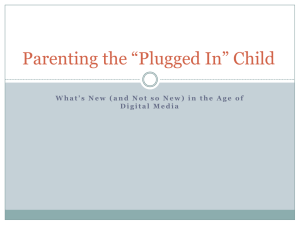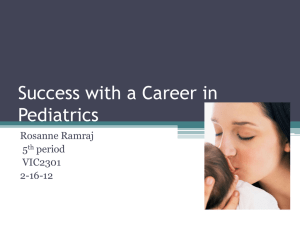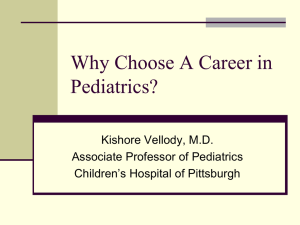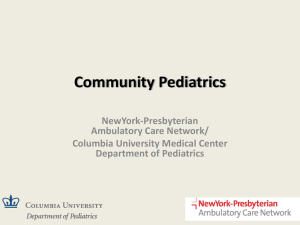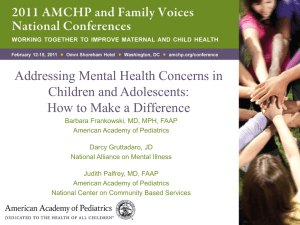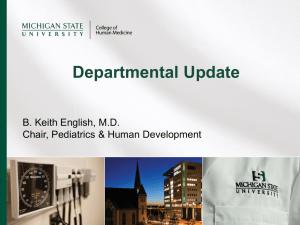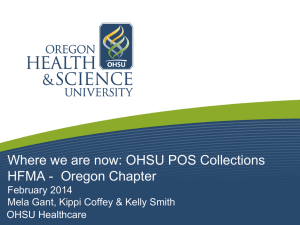2000 - Oregon Pediatric Society
advertisement
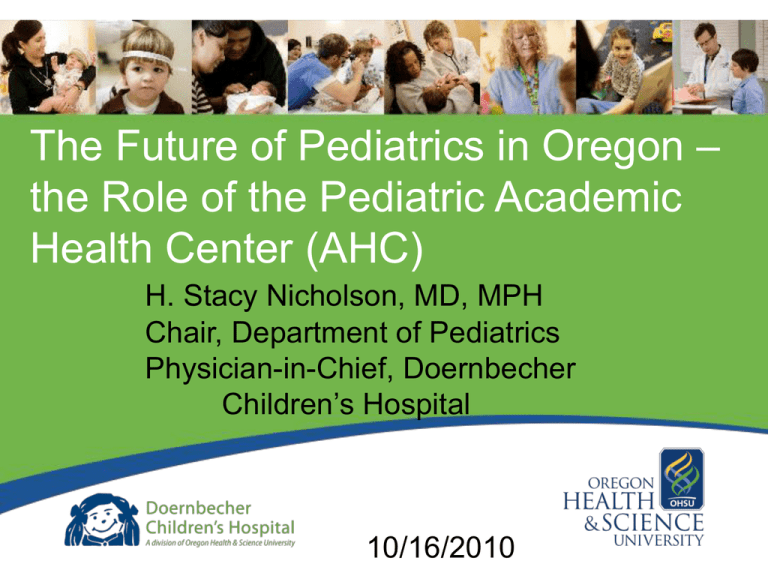
The Future of Pediatrics in Oregon – the Role of the Pediatric Academic Health Center (AHC) H. Stacy Nicholson, MD, MPH Chair, Department of Pediatrics Physician-in-Chief, Doernbecher Children’s Hospital 10/16/2010 Disclosure • No ties to Industry • 5K12 HD 057588 (Child Health Research Center) PI: Nicholson Pediatric Chair’s View of Reality Chevalier, J Pediatr 151:557-558, 2007 Faculty Member’s View Chevalier, J Pediatr 151:557-558, 2007 Academics – Then vs. Now • • • • • 1970s – 1980s “profess”or “teaching rounds” 3 times per week Residents and students were the primary physicians Limited supervision Solid state funding Today • Clinical FTE defined by subtraction • ↑ Productivity demands – wRVU / CFTE – Research funding • ↑ supervision • ↑ direct care by faculty • ↓ state funding OHSU State Funding: 1991 - 2011 $209,531 200,000 Represents the value of 91-93 State Appropriation stated in current dollars 150,000 $132,519 $123,553 $107,600 $107,897 $111,897 $95,978 100,000 $85,779 $82,234 $73,337 $73,311 50,000 - 91-93 93-95 95-97 97-99 99-01 01-03 State Appropriation (in Thousands) 03-05 05-07 07-09 09-11 Academic Pediatrics in USA – Issues • ↑ part-time faculty • ↑ Pressure for Increased Productivity – Tied to compensation • Mission Competition: Care, teaching, research • Financial – ↓ state funding – ↓endowments • Resident Duty Hours / R3P – – – – ↑ clinical work by faculty Changing composition of ‘teams’ ↑ ‘flexibility’ ↓ hours (Pl1s limited to 16 hours in FY12) Academic Pediatrics in USA • Issues (cont’d) – Workforce • Shortage of subspecialists • Maldistribution of Providers – rural vs. urban – Reimbursement • Pediatric reimbursement lower than for adult – Medicaid reimbursement below Medicare • ‘Cognitive’ specialties have lower reimbursement • Universal Coverage / Health Care Reform – Medical Home Decreased Funding for Ped Research • Pediatric Research funded by NIH – 1994 – 2000 – 2005 14.1% 12.6% 11.3% • Pediatric Research in top science journals (Science, Nature, PNAS, J Clin Invest, NEJM) – Declined by 35% from 2000 to 2006 • Children are 25% of the US population Academic Pediatrics in Oregon • OHSU is Oregon’s Academic Health Center (AHC) – ‘top 20’ medical school • Very Competitive Environment in Pediatrics – 4 health systems compete in metro PDX • • • • Competition can make you stronger (+) Fragmentation of Care (-) Potential negative impact on recruitment (-) Potential negative impact on payment from insurers (-) • Urban vs. Rural – Distance to subspecialty pediatrics a barrier to access OHSU – YOUR ACADEMIC HEALTH CENTER Focusing on DCH and the Department of Pediatrics Department of Pediatrics: ‘07 Strategic Plan VISION: Patient Care: We will be the pediatric and adolescent healthcare provider of choice for our region. Education: MISSION: To enhance the health and well-being of children and adolescents by ensuring excellence in patient care, education, research, and advocacy. We will be a leader for excellence in education, the cornerstone of our patient care, research, and advocacy efforts. Research: We will be a leading center for child health research, encompassing basic, clinical, translational, and health services research programs. Advocacy: We will be a strong voice for the health and welfare of children. GOALS: 1) Build a sustainable educational environment that attracts top candidates, cultivates knowledge, and achieves superior outcomes. 2) Grow focused areas of research excellence, building upon existing research strengths in the Department and at OHSU. 3) Enhance healthcare access and improve service to patients and referring providers. 4) Develop, recruit, and retain the best faculty and staff. 5) Solidify the financial position of the Department. 6) Develop partnerships with the community to further our education, research, and patient care missions. 7) Reduce health care inequities among children and adolescents in our region. VALUES: Respect & Integrity Compassion Innovation & Discovery Patient & Family Centered Accountability & Transparency Collaboration OHSU/DCH Pediatric Residency Nationally Competitive >13 2011 season as of Oct 13, 2010 New interns for July 2011 180 Number of interviews scheduled at OHSU 631 Number of US graduate applications to OHSU Pediatric residency ~2000 US applicants to pediatrics DCH Residents are Great on Day 1 • Current intern class (class of 2013) – Average USMLE step 1 score = 225 • Average all peds applicants = 219 • Minimum pass = 188 – Average USMLE step 2 score = 237 • Average all peds applicants = 229 • Minimum pass = 184 – % AOA = 23 % • All peds applicants % = 12% DCH Graduates are Great on Day 1 • American Board of Pediatrics Certification Exam – Last 2 years pass rate = 100% – Overall pass rate (2007-2009) = 98% – Of 189 programs, the number of programs with better pass rate than OHSU= 1 • Mass General = 100% pass rate (94% of eligible took exam) • Mayo Clinic = 98% pass rate (100% of eligible took exam) ABP Pediatric Training Program Pass Rates Changing Career Choices by Grads OHSU/DCH Pediatric Residency Nationally Competitive ?? 2011 season as of Oct 13, 2010 New interns for July 2011 180 Number of interviews scheduled at OHSU 631 Number of US graduate applications to OHSU Pediatric residency ~2000 US applicants to pediatrics Department of Pediatrics Research Awards & Indirect Costs: Past 7 Years Dept of Pediatrics - Overall Research Productivity Awards Received vs Budgeted IDC 18,000,000 3,500,000 16,000,000 3,000,000 14,000,000 10,000,000 2,000,000 8,000,000 1,500,000 6,000,000 1,000,000 4,000,000 500,000 2,000,000 0 0 FY04 FY05 FY06 FY07 FY08 FY09 FY10* Total Awards - Direct + IDC Budgeted IDC *NOTE: FY10 Data is Estimated thru the end of the Fiscal Year IDC ($) Awards Received ($) 2,500,000 12,000,000 OREGON – A FEW REMARKS ABOUT CHILD HEALTH Healthy Kids (OR) • Insurance tax (1%): $105M over 2 years • $240M in matching federal funds – 80,000 uninsured kids to get coverage by 6/11 • Hospital tax (up to 5.5%): – 35,000 uninsured adults to get coverage • OR – 1 of 12 states to guarantee universal coverage for kids – But…………. Coverage does not equal access. Workforce Issues in OR • To get OR to national numbers (#providers per 100k kids) – – – – – – – 7 cardiologists 1 critical care 7 emergency med 3 GI 3 Heme/Onc 3 ID 8 Neonatologists – 1 Nephrologist – 3 pulm – 1 rheum – 42 general peds Adol, Develop, Endo above national avg Impact of Recent Depression on OR Families & Children Persistent High Unemployment July, 2009 July, 2010 Change USA 9.4% 9.5% + 0.1% Oregon 11.4% 10.6% - 0.8% Washington 9.2% 8.9% - 0.3% Lower Birth Rates Jan-Jun ‘08 Jul-Dec ‘08 Jan-Jun ‘09 Jul-Dec ‘09 Jan-Jun ‘10 Metro PDX 11,621 11,268 11,181 11,138 10,102 Oregon 24,991 24,505 23,892 23,783 21,907 OVERALL RANKINGS OVER TIME 0 5 10 Oregon Washington 15 20 25 Source: 2010 Annie E. Casey Foundation Kids Count Data Book OR CHILD HEALTH – ROADMAP TO TOP 10 Item Current Rank (2010) Current Rate / Percentage Improvement Needed Infant Mortality Rate 11 5.8 / 1,000 - 0.2 / 1,000 Child Death Rate 14 17 / 100,000 - 2 / 100,000 % Gaps in Family Employment 29 29% - 6% % of Children in Poverty 27 18% - 5% % of Children in Single Parent Homes 16 30% - 2% Teen birth rate 18 36 / 1,000 - 6 / 1,000 % high school dropouts 15 6% - 1% % dropouts not employed 34 9% - 3% Rate of Return to Investment in Human Capital High Gains High Gains Low Gains Age Low Gains JJ Heckman, 2000 0 JJ Heckman, 2000 Age HEALTH CARE REFORM Real Health Care Reform • Providers work at the top of their license / training – Primary care / prevention work will be increasingly done by nonMDs – PCPs will see sicker kids and take on more routine subspecialty care (CSHCN, Chronic disease, etc.) – Subspecialists • Work more closely with PCPs • Only see the most complicated patients / provide treatment • Patients & Families – the most underutilized resource in healthcare – Electronic data will enable clinical decisions • Systems and Networks will replace older business models • Roadmap from here to there? Christensen, Clayton, The Innovator’s Prescription, 2009 Concluding Remarks • Oregon – the Goldilocks State – ~ 4 million people – ~ 1 million kids – Significant barriers to care access • SES – rural & frontier populations • Geographic • We can show the USA how to take better care of kids – By working together in care delivery – By working together in advocacy The Future of Pediatrics in Oregon – the Role of the Pediatric Academic Health Center (AHC) H. Stacy Nicholson, MD, MPH Chair, Department of Pediatrics Physician-in-Chief, Doernbecher Children’s Hospital 10/16/2010
